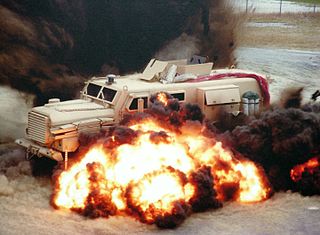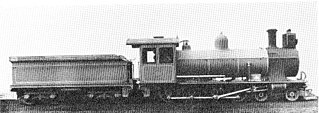
Theridiidae, also known as the tangle-web spiders, cobweb spiders and comb-footed spiders, is a large family of araneomorph spiders first described by Carl Jakob Sundevall in 1833. This diverse, globally distributed family includes over 3,000 species in 124 genera, and is the most common arthropod found in human dwellings throughout the world.
RG, Rg or rg may refer to:

The Mamba is a South African infantry mobility vehicle designed for internal security purposes. It was developed during the late 1980s to replace the Buffel in service with the South African military and security forces. The first models were built on a 4X2 Toyota Dyna chassis, which was subsequently replaced in production around 1994 by a more reliable Unimog chassis. All marks of the Mamba were designed to be mine-resistant and blastproof.

The RG-31 Nyala is a 4×4 multi-purpose Mine-Resistant Ambush Protected Vehicle manufactured in South Africa by Land Systems OMC, located in Benoni, South Africa and in Turkey by FNSS Defence Systems. It is based on the Mamba APC of TFM Industries.

The RG-32 Scout is a family of mine-resistant 4×4 light armoured vehicles made by BAE Systems Land Systems South Africa in South Africa. It is based on the RG-31, which is already deployed worldwide with peace-keeping, security and combat forces. The combat weight of the vehicle is about 7,300 kg and it has the capacity to carry a crew of 5 to 7. The vehicle crew is protected against 5.56×45mm NATO ball ammunition, grenades, firebombs, anti-personnel mines and side blasts. The five-seat version also offers protection against anti-tank mines and side blasts. Up to two RG-32Ms can be transported in a C-130 cargo aircraft.

The RG-12 is a multi-purpose armoured personnel carrier with anti-personnel mine, grenade, fire bomb and small arms fire protection that is manufactured by Land Systems OMC of South Africa, with over 700 being in service globally in more than eight countries.
Land Systems OMC is a South African company that produces a range of armoured vehicles which have been successfully exported and are in service with, amongst others, the U.S., Canadian and South African militaries. It is a division of Denel SOC LTD, located in Benoni, Gauteng.

The RG-33 is a mine-resistant light armored vehicle initially designed by BAE Systems Land Systems South Africa, a South African subsidiary of BAE Systems. BAE Systems in the US extensively modified it with additional protection, new powertrain, and suspension systems. It was built in a number of locations including York, Pennsylvania. It was one of several vehicles being fielded by the US Armed Forces in Iraq under the United States MRAP program.

The REVA Armoured Personnel Carrier (APC) is a mine-protected vehicle. It is produced by Integrated Convoy Protection. The vehicle’s V-shaped hull offers protection against land mines and Improvised Explosive Devices (IED)s. The vehicle has space for at least 10 passengers. Ten firing ports are also available. Two light machine guns can be used and cover a 360-degree on roller bearing turret hatches.

Mine-Resistant Ambush Protected Vehicle (MRAPV), also known as MRAP Vehicle, is a type of armoured personnel carrier that are designed specifically to withstand land mines, improvised explosive device (IED) attacks and ambushes to save troops' lives. Most modern Infantry mobility vehicle also have certain level of MRAP capabilities.
The RG-19 Caddie is a prototype Armoured Personnel carrier manufactured by TFM of South Africa. The company was later taken over by Reunert Defence OMC.

The RG-34 is a South African Mine-Resistant Ambush Protected vehicle (MRAP). Specially designed to be mine-resistant, it has been produced in multiple variants, equipped for troop or cargo transport, command, and fire support. Originally showcased with a wide turret ring and a 90mm rifled cannon, the RG-34 was one of the first MRAPs configured to carry a large gun system.

RG-35, is a South African mine resistant ambush protected vehicle developed by Land Systems OMC, a subsidiary of BAE Systems. The RG-35 was introduced in 2009 as a 6x6 vehicle, and a 4x4 version is also under development with the designers intending to make it a new family of vehicles. Described by BAE Systems as a "new class of vehicle" combining the capabilities of a 4x4 mine protected vehicle and a 8x8 combat vehicle, the RG-35 can be utilized in a variety of roles, including command, ambulance or recovery vehicle.

The RG Outrider, also known by its original designation RG-32M light tactical vehicle (LTV), is a 4x4 multi-purpose mine-protected armoured personnel carrier (APC) manufactured by BAE Systems of South Africa. It was first introduced in early 2009 as the RG-32M LTV, and was first purchased by Ireland. The vehicle was offered to the US market the following year, re-designated as RG Outrider. It is based on and is the successor to the RG-32M already in service in Afghanistan with the coalition forces. The RG Outrider offers several improvements over its predecessor, including the addition of the V-shaped hull.

The South African Railways Class 7 4-8-0 of 1892 is a steam locomotive from the pre-Union era in the Cape of Good Hope.

The South African Railways Class 7A 4-8-0 of 1896 was a steam locomotive from the pre-Union era in the Cape of Good Hope.

The South African Railways Class 7C 4-8-0 of 1902 was a steam locomotive from the pre-Union era in the Cape of Good Hope.

The South African Railways Class 7D 4-8-0 of 1915 was a steam locomotive.

The South African Railways Class 7E 4-8-0 of 1899 was a steam locomotive from the pre-Union era in the Cape of Good Hope.

Rudolph Gerhardus Snyman is a South African rugby union player who plays as a lock for Irish United Rugby Championship club Leinster and the South Africa national team. Snyman was part of the South Africa team that won the Rugby World Cup in 2019 and 2023, and is widely known as 'The Viking' among fans and teammates in reference to his appearance.

















